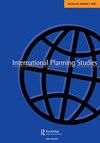Soft planning in macro-regions and megaregions: creating toothless spatial imaginaries or new forces for change?
IF 1.5
Q4 REGIONAL & URBAN PLANNING
引用次数: 6
Abstract
ABSTRACT Both planning practice and research increasingly acknowledge the existence of new scales and governance arrangements alongside and between statutory planning systems. Examples of new scales of non-statutory planning are large-scale megaregions and macro-regions. Drawing on examples from North America and Europe (Southern California and the Danube Region respectively), this article examines how new processes of cooperation at this scale can influence other statutory levels of decision-making on spatial development. The analysis of spatial delineations, discourses, actors, rules and resources associated with megaregions and macro-regions suggests that this type of ‘soft planning’ can foster territorial integration when a perception exists that there are joint gains to be made, when informal rules are negotiated in context-specific and bottom-up processes, when soft spaces are used as arenas of deliberation to renegotiate shared agendas, and when actors succeed in ensuring the anchorage of informal cooperation in other arenas.宏观区域和超大区域的软规划:创造没有牙齿的空间想象还是变革的新力量?
规划实践和研究越来越多地认识到,在法定规划制度的同时,以及在法定规划制度之间,存在新的规模和治理安排。非法定规划新规模的例子包括大型特大地区和宏观区域。本文以北美和欧洲(分别为南加州和多瑙河地区)为例,探讨了这种规模的新合作进程如何影响其他法定层面的空间发展决策。对与大区域和宏观区域相关的空间划分、话语、参与者、规则和资源的分析表明,当存在一种可以共同获得利益的感知时,当非正式规则在特定情境和自下而上的过程中进行谈判时,当软空间被用作重新谈判共同议程的审议场所时,这种类型的“软规划”可以促进领土一体化。当行动者成功地确保在其他领域的非正式合作的锚定时。
本文章由计算机程序翻译,如有差异,请以英文原文为准。
求助全文
约1分钟内获得全文
求助全文
来源期刊

International Planning Studies
REGIONAL & URBAN PLANNING-
CiteScore
4.60
自引率
4.80%
发文量
20
期刊介绍:
Planning, at urban, regional, national and international levels, faces new challenges, notably those related to the growth of globalisation as both an objective socio-economic process and a shift in policy-maker perceptions and modes of analysis. International Planning Studies (IPS) addresses these issues by publishing quality research in a variety of specific fields and from a range of theoretical and normative perspectives, which helps improve understanding of the actual and potential role of planning and planners in this context.
 求助内容:
求助内容: 应助结果提醒方式:
应助结果提醒方式:


